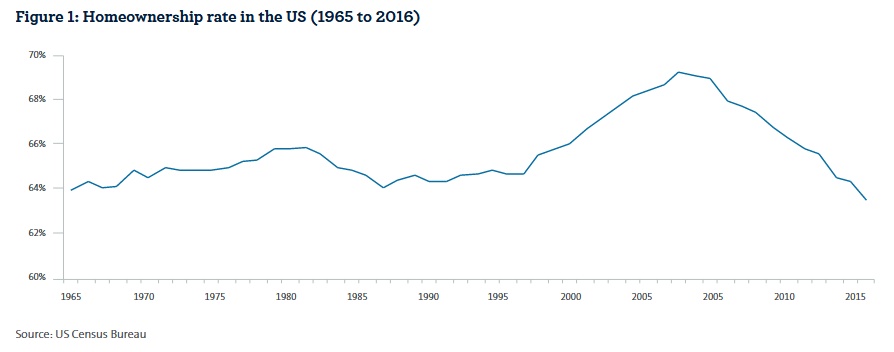A report by AMP says a major demographic shift in the US has contributed to a steady decline in home ownership since the Global Financial Crisis (GFC), with Generation Y dubbed Generation Rent as millennials delay purchasing a home in the suburbs in favour of renting in the urban core.
A new AMP Capital whitepaper, Generation Rent, explores this trend, the implications for real estate investors and the opportunities within the US apartment REIT sector.
AMP Capital Client Portfolio Manager for Global Listed Real Estate and report author Chris Deves said: “The greater propensity for millennials to rent isn’t necessarily a surprise. After all, this is the same generation that pioneered the ‘sharing economy’, a collaborative approach to consumption, which draws heavily on the notion of renting.
“Millennials are opting for proximity to nightlife, restaurants and the workplace along with access to shared spaces and amenities, which is translating into greater demand for rented apartments in the urban core. As a demographic cohort, the strong willingness of millennials to relocate in the pursuit of new career opportunities necessitates flexibility and mobility, which is also more conducive to renting over owning.”
The paper shows this is an important tailwind for US apartment REITs, which make up roughly 8 per cent of the global listed real estate benchmark or more than US$100 billion of equity market capitalisation.
“On a through-cycle basis, this shift is a positive for residential landlords and, in turn, a positive for investors in the listed institutional apartment operators, which have asset portfolios with meaningful exposure to key urban centres.
“Apartment REITs are generally high quality and consolidation in the sector has left a set of large, well-capitalised companies with seasoned management teams, making them attractive for real estate investors with a long-term investment horizon,” Mr Deves said.
Mr Deves notes that millennials won’t, however, rent forever. He said: “The American dream of home ownership is not dead and buried. Gen Y are just as likely to head for the suburbs as previous generations, and starting a family is often an important catalyst. The key difference is that we are seeing this occur increasingly later in life.
“Cyclical affordability issues and demographic change has and will support demand for apartment rentals in city centres. During the property cycle, the US apartment REITs should therefore be in a stronger position to push rents, and quality management teams with insight into the needs of millennials will be best placed to deliver value for investors of all sizes.”
While the story is similar for Australian millennials, investing in the US is the best way to play this trend for local investors as it offers the largest, highest quality, and most liquid set of listed apartment landlords.
Mr Deves said: “Australian investors should consider a global strategy for listed real estate in order to access these kinds of thematics, which may not be as readily investible in their local market. A global approach also offers geographic diversification for the real estate portfolio.”

